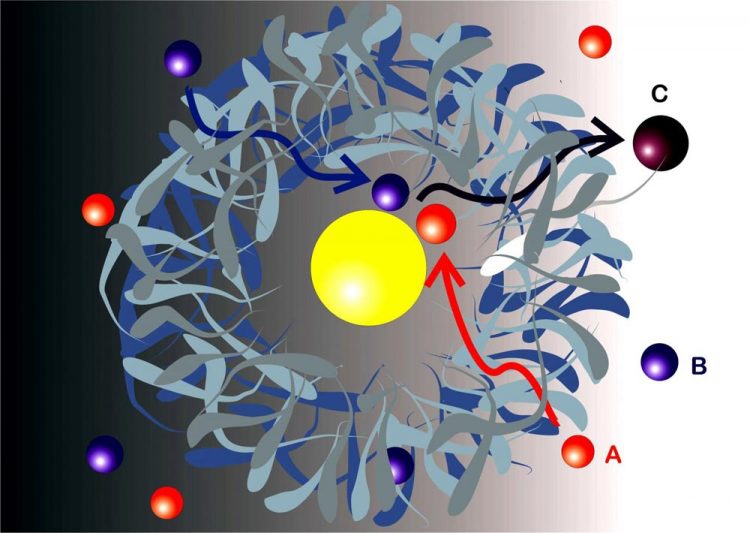New model for bimolecular reactions in nanoreactors

Reactants A and B diffuse through the shell and react to product C at the catalytically active nanoparticle (yellow) inside. Credit: HZB
Mathematical description delivers new insights
“We have now mathematically described for the first time how two different molecules are transported to react within nanoreactors. The new model shows clearly what factors favour a given reaction”, says Dr. Rafael Roa. Roa is first author of the publication in ACS Catalysis and a postdoc in the group headed by Prof. Joe Dzubiella at the HZB Institute for Soft Matter and Functional Materials.
What matters most?
Some of the results come as a surprise: contrary to expectations, the reaction rate is not so much limited by the concentration of the molecules in solution, but decisively by the permeability of the nanoreactor's shell. “This is extremely interesting since chemists today can often fine tune or even switch the permeability of these shells to specific molecules via variations in temperature or other parameters”, explains co-author Dr. Won Kyu Kim.
Photo-activation taken into account
The new model is a big step forward from the older theory done many decades earlier that could handle only one molecule. “Our model is applicable to research on energy materials, and it can even take into account photo-activation of one of the molecules at the shell by sunlight”, Dzubiella states. He has achieved with this work one of the goals of his European Research Council (ERC) Consolidator Grant (2015-2020).
Predictions will be put to test
Dzubiella's Soft Matter Theory group collaborates with HZB chemist Prof. Yan Lu, an acknowledged expert in synthetic nanoreactors. They are eager to test their theoretical predictions on real systems. “We're now able to better understand what happens, and we expect to predict how the catalytic effects of these types of nanoreactors can be controlled – through feedback loops, for instance, which will stop or start the reaction at will.”
###
The project was fundet by the ERC Consolidator Project “NANOREACTOR” of Prof. Dzubiella and results are published in ACS Catalysis (2017): “Catalyzed Bimolecular Reactions in Responsive Nanoreactors”. Rafael Roa, Won Kyu Kim, Matej Kanduč,Joachim Dzubiella, Stefano Angioletti-Uberti.
Media Contact
All latest news from the category: Materials Sciences
Materials management deals with the research, development, manufacturing and processing of raw and industrial materials. Key aspects here are biological and medical issues, which play an increasingly important role in this field.
innovations-report offers in-depth articles related to the development and application of materials and the structure and properties of new materials.
Newest articles

Recovering phosphorus from sewage sludge ash
Chemical and heat treatment of sewage sludge can recover phosphorus in a process that could help address the problem of diminishing supplies of phosphorus ores. Valuable supplies of phosphorus could…

Efficient, sustainable and cost-effective hybrid energy storage system for modern power grids
EU project HyFlow: Over three years of research, the consortium of the EU project HyFlow has successfully developed a highly efficient, sustainable, and cost-effective hybrid energy storage system (HESS) that…

After 25 years, researchers uncover genetic cause of rare neurological disease
Some families call it a trial of faith. Others just call it a curse. The progressive neurological disease known as spinocerebellar ataxia 4 (SCA4) is a rare condition, but its…





















